355 nm Nanosecond Ultraviolet Pulsed Laser Annealing Effects on Amorphous In-Ga-ZnO Thin Film Transistors
Abstract
1. Introduction
2. Experimental Methods
3. Results and Discussion
3.1. Current-Voltage Characteristics Depending on Laser Annealing Powers
3.2. Structural Characteristics and Energy Band Analysis Depending on Laser Annealing Powers
4. Conclusions
Supplementary Materials
Author Contributions
Funding
Data Availability Statement
Conflicts of Interest
References
- Naqi, M.; Cho, Y.; Kim, S. High-Speed Current Switching of Inverted-Staggered Bottom-Gate a-IGZO-Based Thin-Film Transistors with Highly Stable Logic Circuit Operations. ACS Appl. Electron. Mater. 2023, 5, 3378–3383. [Google Scholar] [CrossRef]
- Fortunato, E.; Barquinha, P.; Martins, R. Oxide Semiconductor Thin-Film Transistors: A Review of Recent Advances. Adv. Mater. 2012, 24, 2945–2986. [Google Scholar] [CrossRef] [PubMed]
- Ji, X.; Yuan, Y.; Yin, X.; Yan, S.; Xin, Q.; Song, A. High-Performance Thin-Film Transistors with Sputtered IGZO/Ga2O3 Heterojunction. IEEE Trans. Electron Devices 2022, 69, 6783–6788. [Google Scholar] [CrossRef]
- Striakhilev, D.; Park, B.-K.; Tang, S.-J. Metal oxide semiconductor thin-film transistor backplanes for displays and imaging. MRS Bull. 2021, 46, 1063–1070. [Google Scholar] [CrossRef]
- Park, J.S.; Maeng, W.-J.; Kim, H.-S.; Park, J.-S. Review of recent developments in amorphous oxide semiconductor thin-film transistor devices. Thin Solid Film 2012, 520, 1679–1693. [Google Scholar] [CrossRef]
- Nomura, K. Recent progress of oxide-TFT-based inverter technology. J. Inf. Disp. 2021, 22, 211–229. [Google Scholar] [CrossRef]
- Hosono, H. Ionic amorphous oxide semiconductors: Material design, carrier transport, and device application. J. Non-Cryst. Solids 2006, 352, 851–858. [Google Scholar] [CrossRef]
- Kamiya, T.; Hosono, H. Material characteristics and applications of transparent amorphous oxide semiconductors. NPG Asia Mater. 2010, 2, 15–22. [Google Scholar] [CrossRef]
- Wu, G.M.; Liu, C.Y.; Sahoo, A.K. RF sputtering deposited a-IGZO films for LCD alignment layer application. Appl. Surf. Sci. 2015, 354, 48–54. [Google Scholar] [CrossRef]
- Troughton, J.; Atkinson, D. Amorphous InGaZnO and metal oxide semiconductor devices: An overview and current status. J. Mater. Chem. C 2019, 7, 12388–12414. [Google Scholar] [CrossRef]
- Kamiya, T.; Nomura, K.; Hosono, H. Present status of amorphous In–Ga–Zn–O thin-film transistors. Sci. Technol. Adv. Mater. 2010, 11, 044305. [Google Scholar] [CrossRef] [PubMed]
- Kang, D.H.; Kang, I.; Ryu, S.H.; Jang, J. Self-Aligned Coplanar a-IGZO TFTs and Application to High-Speed Circuits. IEEE Electron Device Lett. 2011, 32, 1385–1387. [Google Scholar] [CrossRef]
- De Jamblinne De Meux, A.; Bhoolokam, A.; Pourtois, G.; Genoe, J.; Heremans, P. Oxygen vacancies effects in a-IGZO: Formation mechanisms, hysteresis, and negative bias stress effects. Phys. Status Solidi (A) 2017, 214, 1600889. [Google Scholar] [CrossRef]
- Nomura, K.; Ohta, H.; Takagi, A.; Kamiya, T.; Hirano, M.; Hosono, H. Room-temperature fabrication of transparent flexible thin-film transistors using amorphous oxide semiconductors. Nature 2004, 432, 488–492. [Google Scholar] [CrossRef] [PubMed]
- Jianke, Y.; Ningsheng, X.; Shaozhi, D.; Jun, C.; Juncong, S.; Shieh, H.D.; Po-Tsun, L.; Yi-Pai, H. Electrical and Photosensitive Characteristics of a-IGZO TFTs Related to Oxygen Vacancy. IEEE Trans. Electron Devices 2011, 58, 1121–1126. [Google Scholar] [CrossRef]
- Inoue, H.; Matsuzaki, T.; Nagatsuka, S.; Okazaki, Y.; Sasaki, T.; Noda, K.; Matsubayashi, D.; Ishizu, T.; Onuki, T.; Isobe, A.; et al. Nonvolatile Memory with Extremely Low-Leakage Indium-Gallium-Zinc-Oxide Thin Film Transistor. IEEE Solid-State Circuits 2012, 47, 2258. [Google Scholar] [CrossRef]
- Lee, H.-W.; Cho, W.-J. Effects of vacuum rapid thermal annealing on the electrical characteristics of amorphous indium gallium zinc oxide thin films. AIP Adv. 2018, 8, 015007. [Google Scholar] [CrossRef]
- Peng, C.; Yang, S.; Pan, C.; Li, X.; Zhang, J. Effect of Two-Step Annealing on High Stability of a-IGZO Thin-Film Transistor. IEEE Trans. Electron Devices 2020, 67, 4262–4268. [Google Scholar] [CrossRef]
- Lee, M.K.; Kim, C.-K.; Park, J.W.; Kim, E.; Seol, M.-L.; Park, J.-Y.; Choi, Y.-K.; Park, S.-H.K.; Choi, K.C. Electro-Thermal Annealing Method for Recovery of Cyclic Bending Stress in Flexible a-IGZO TFTs. IEEE Trans. Electron Devices 2017, 64, 3189–3192. [Google Scholar] [CrossRef]
- Fuh, C.-S.; Liu, P.-T.; Chou, Y.-T.; Teng, L.-F.; Sze, S.M. Role of Oxygen in Amorphous In-Ga-Zn-O Thin Film Transistor for Ambient Stability. ECS J. Solid State Sci. Technol. 2013, 2, Q1–Q5. [Google Scholar] [CrossRef]
- Kim, K.H.; Kwon, H.-I.; Kwon, S.J.; Cho, E.S. Effects of the Pulse Repetition Numbers of Xenon Flash Lamp on the Electrical Characteristics of a-IGZO Thin Films Transistor. J. Semicond. Technol. Sci. 2019, 19, 178–183. [Google Scholar] [CrossRef]
- Hwang, J.-H.; Kim, H.J.; Kim, B.-K.; Jin, W.-B.; Kim, Y.; Chung, H.; Park, S. Scanning multishot irradiations on a large-area glass substrate for Xe-Arc flash lamp crystallization of amorphous silicon thin-film. Int. J. Therm. Sci. 2015, 91, 1–11. [Google Scholar] [CrossRef]
- Wager, J.F. TFT Technology: Advancements and Opportunities for Improvement. Inf. Disp. 2020, 36, 9–13. [Google Scholar] [CrossRef]
- Goto, T.; Saito, K.; Imaizumi, F.; Hatanaka, M.; Takimoto, M.; Mizumura, M.; Gotoh, J.; Ikenoue, H.; Sugawa, S. LTPS Thin-Film Transistors Fabricated Using New Selective Laser Annealing System. IEEE Trans. Electron Devices 2018, 65, 3250–3256. [Google Scholar] [CrossRef]
- Shan, F.; Sun, H.-Z.; Lee, J.-Y.; Pyo, S.; Kim, S.-J. Improved High-Performance Solution Processed In2O3; Thin Film Transistor Fabricated by Femtosecond Laser Pre-Annealing Process. IEEE Access 2021, 9, 44453–44462. [Google Scholar] [CrossRef]
- Lee, J.-Y.; Shan, F.; Kim, H.-S.; Kim, S.-J. Effect of Femtosecond Laser Postannealing on a-IGZO Thin-Film Transistors. IEEE Trans. Electron Devices 2021, 68, 3371–3378. [Google Scholar] [CrossRef]
- Shan, F.; Lee, J.-Y.; Zhao, H.-L.; Choi, S.G.; Koh, J.-H.; Kim, S.-J. Multi-stacking Indium Zinc Oxide Thin-Film Transistors Post-annealed by Femtosecond Laser. Electron. Mater. Lett. 2021, 17, 451–458. [Google Scholar] [CrossRef]
- Nakata, M.; Takechi, K.; Azuma, K.; Tokumitsu, E.; Yamaguchi, H.; Kaneko, S. Improvement of InGaZnO4 Thin Film Transistors Characteristics Utilizing Excimer Laser Annealig. Appl. Phys. Exp. 2009, 2, 021102. [Google Scholar] [CrossRef]
- Bermundo, J.P.; Ishikawa, Y.; Fujii, M.N.; Nonaka, T.; Ishihara, R.; Ikenoue, H.; Uraoka, Y. Effect of eximer laser annealing o a-InGaZnO thin film transistors passivated by solution-processed hybrid passivation layers. J. Phys. D Appl. Phys. 2016, 49, 035102. [Google Scholar] [CrossRef]
- Chung, C.-Y.; Zhu, B.; Ast, D.G.; Greene, R.G.; Thompson, M.O. High mobility amorphous InGaZnO4 thin film transistors formed by CO2 laser spiking annelaing. Appl. Phys. Lett. 2015, 106, 123506. [Google Scholar] [CrossRef]
- Ahn, M.H.; Cho, E.S.; Kwon, S.J. Characteristics of the ITO resistive touch panel deposited on the PET substrate using in-line DC magnetron sputtering. Vacuum 2014, 101, 221–227. [Google Scholar] [CrossRef]
- Zhao, Z.; Kwon, S.J.; Jeon, Y.; Cho, E.-S. Rapid Photonic Curing Effects of Xe-Flash Lanp on ITO-Ag-ITO Miultilayer Electrodes: Toward High-throughput Flexible and Transparent Electronics. Sci. Rep. 2023, 13, 1342. [Google Scholar] [CrossRef]
- Adler, A.U.; Yeh, T.C.; Buchholz, D.B.; Chang, R.P.H.; Mason, T.O. Quasi-reversible point defect relaxation in amorphous In-Ga-Zn-O thin films by in situ electrical measurements. Appl. Phys. Lett. 2013, 102, 122103. [Google Scholar] [CrossRef]
- Kim, J.W.; Kim, A. Absolute work function measurement by using photoelectron spectroscopy. Curr. Appl. Phys. 2021, 31, 52–59. [Google Scholar] [CrossRef]
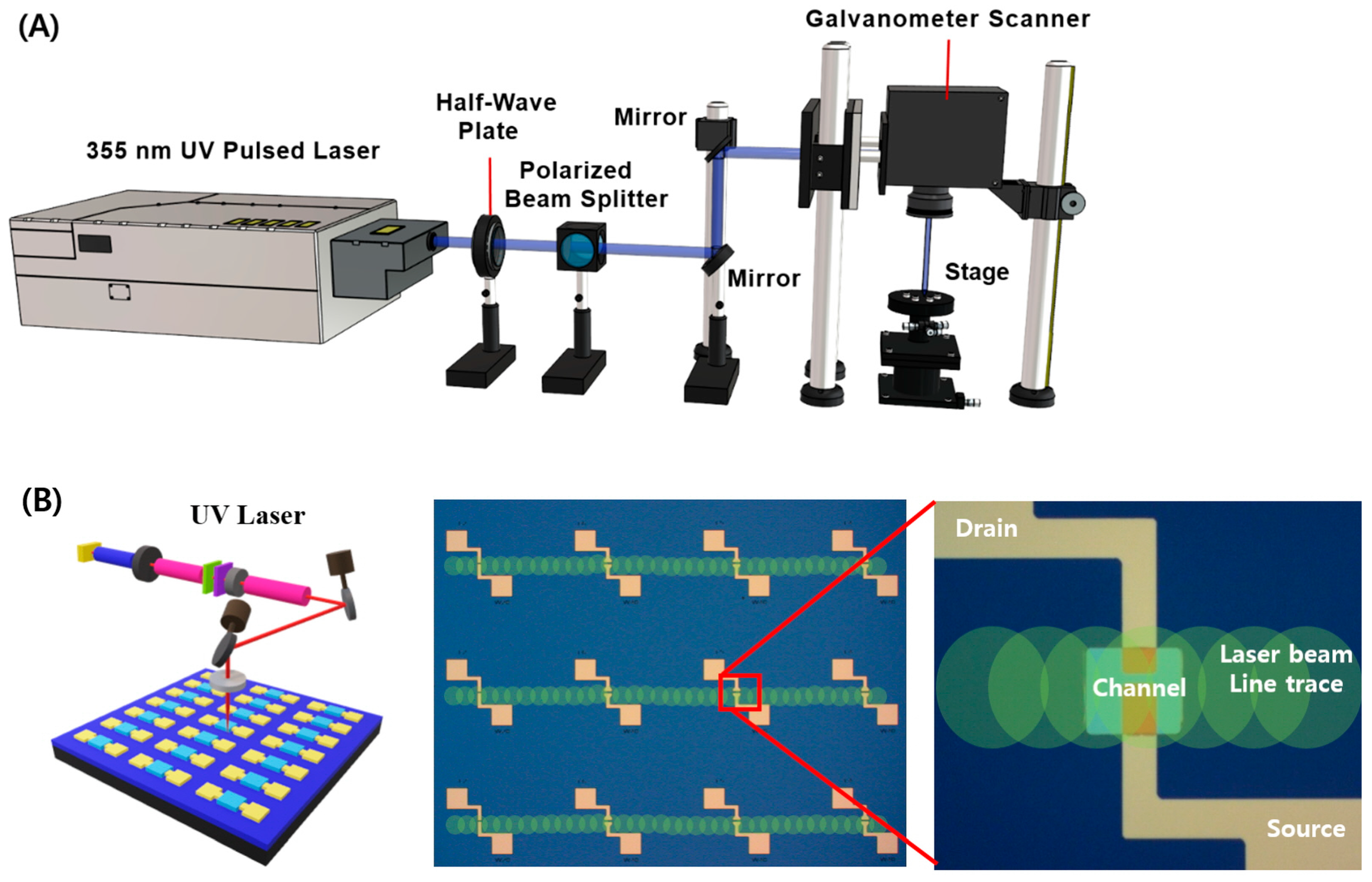
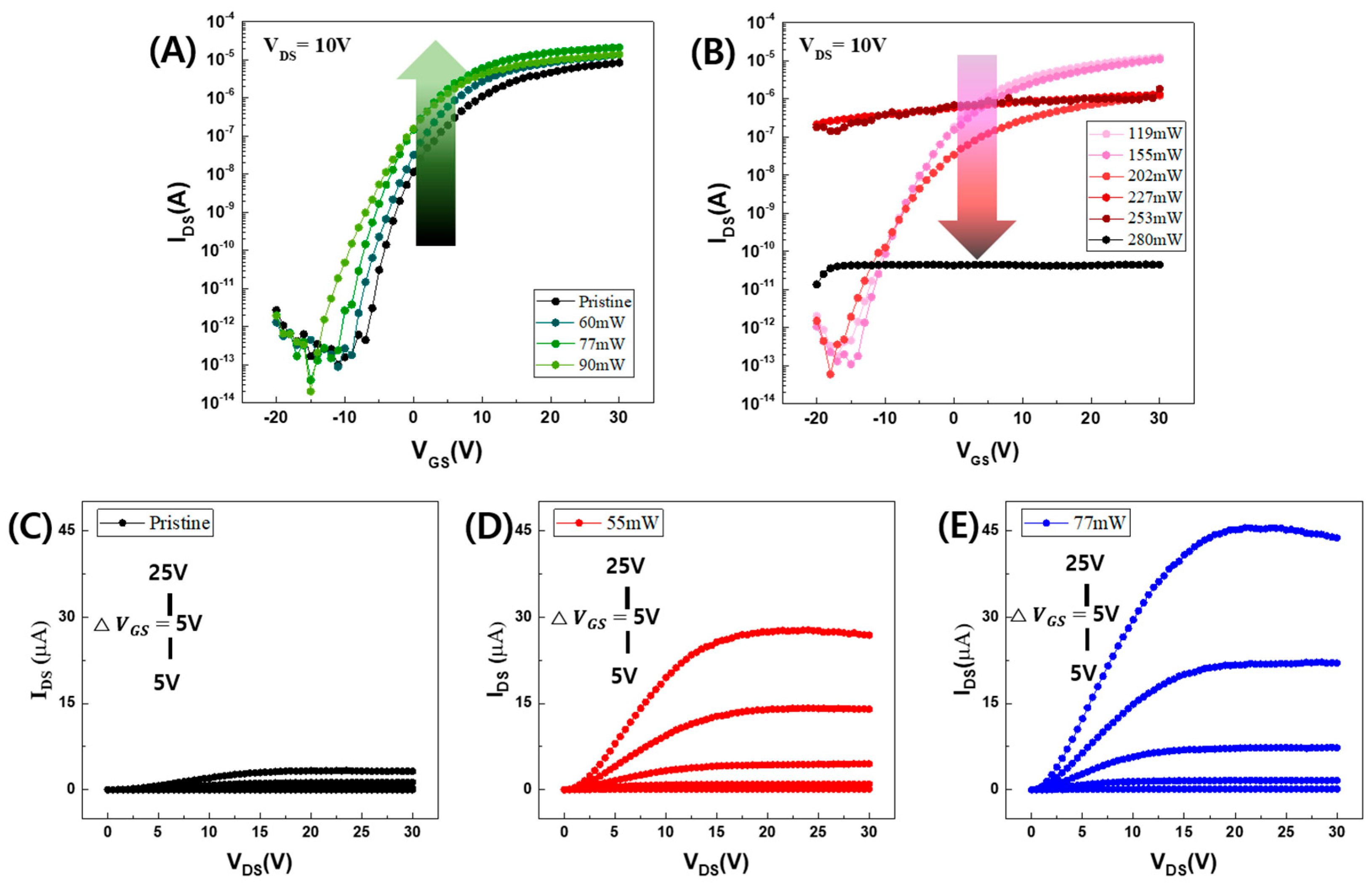
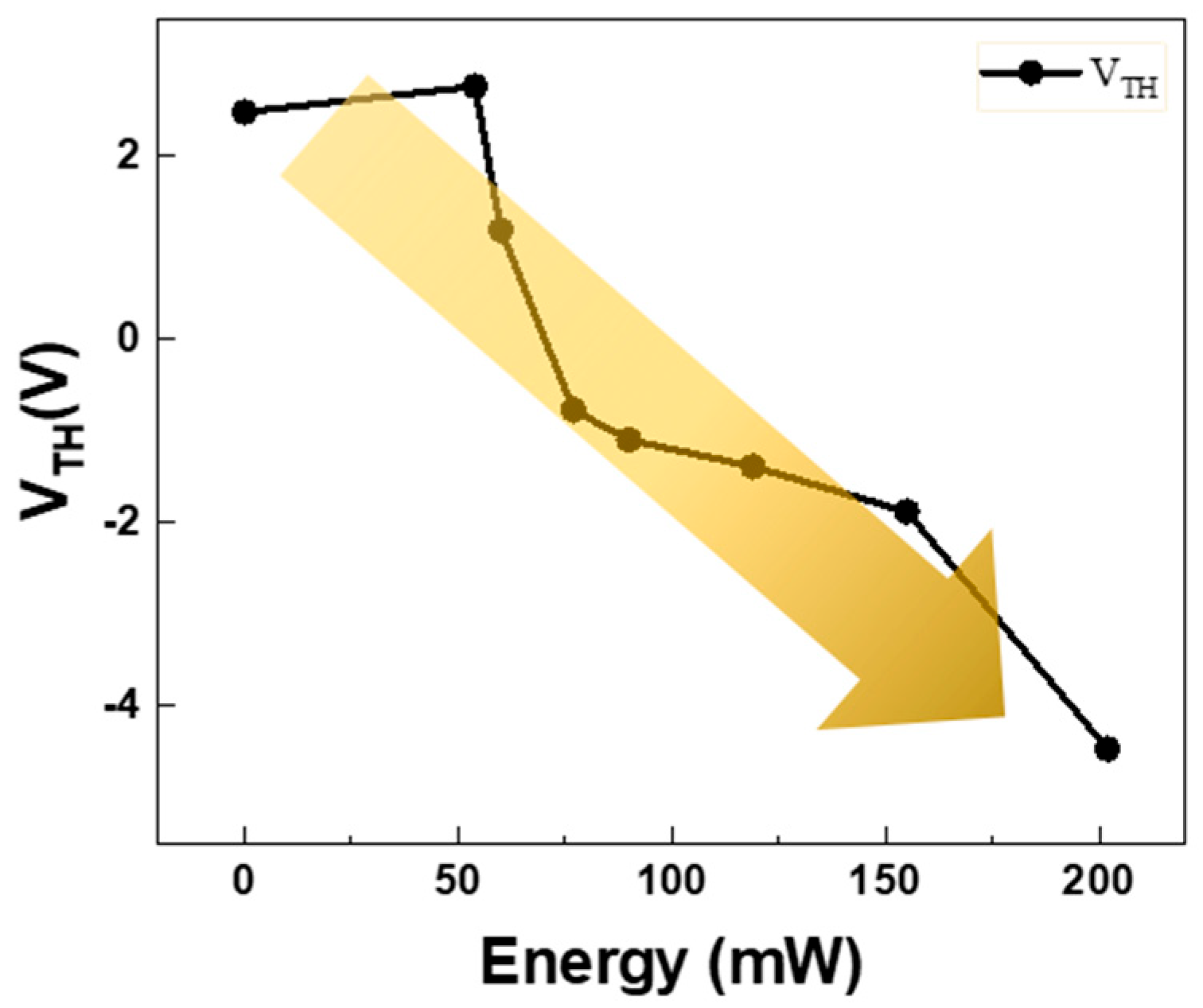
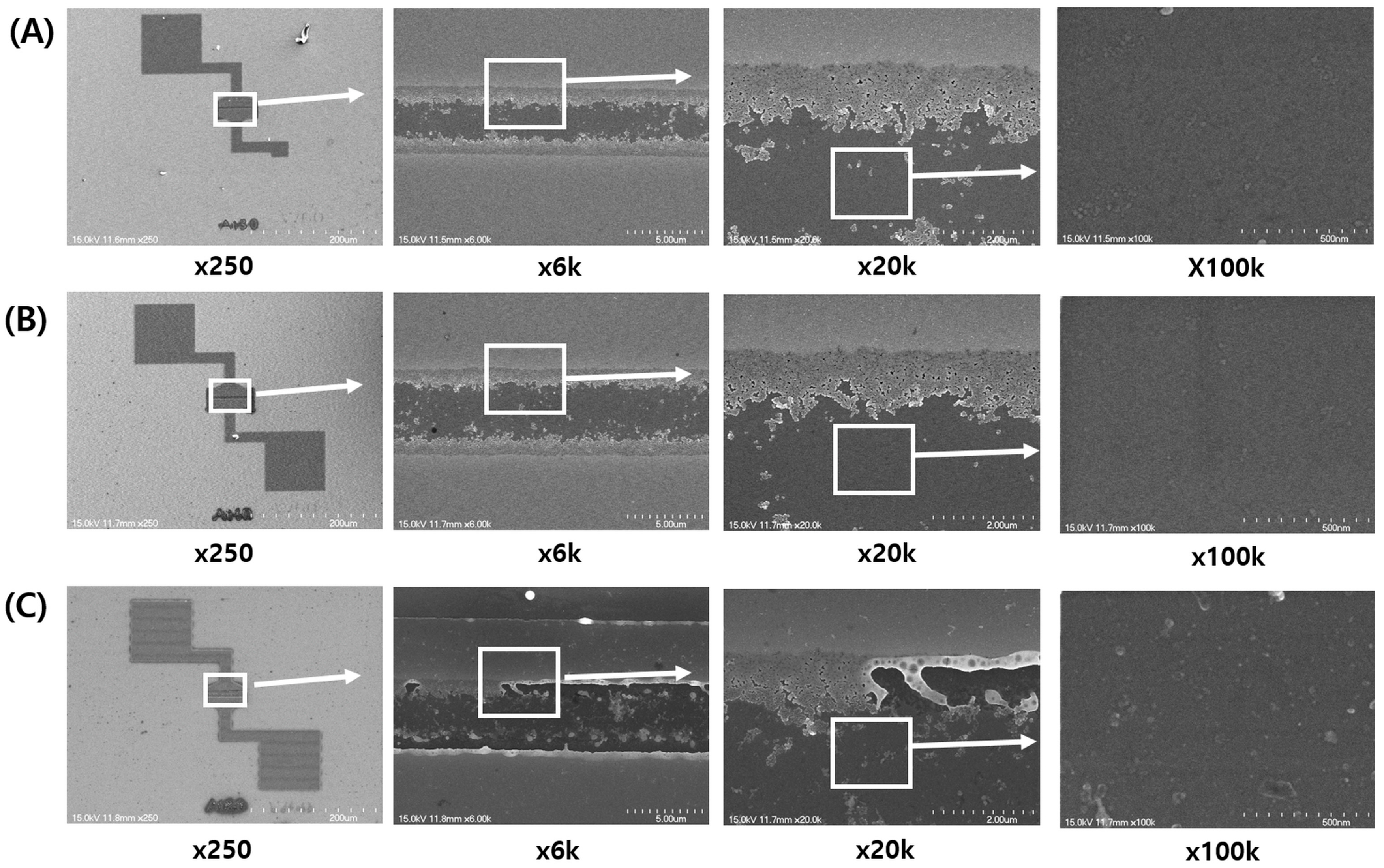

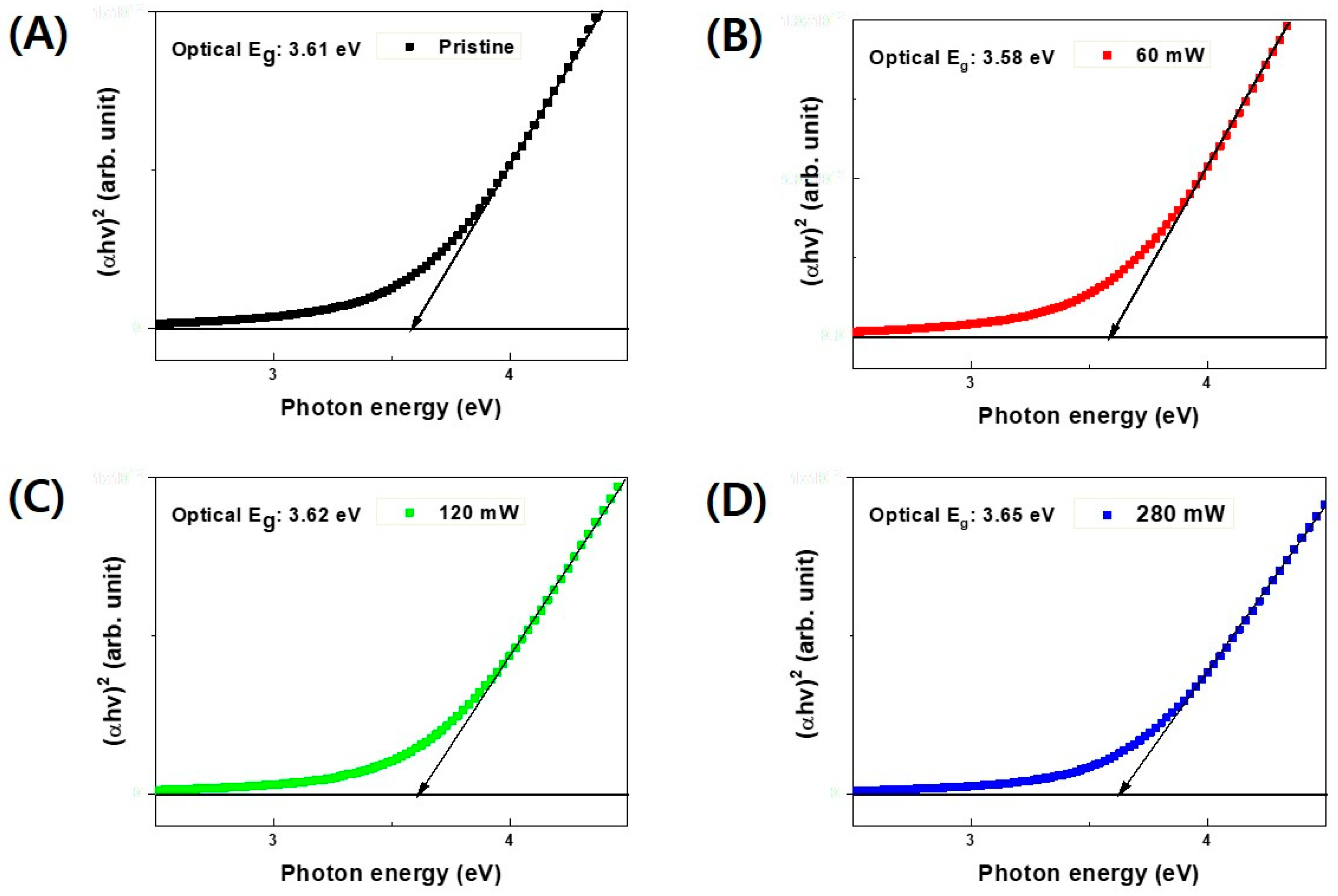

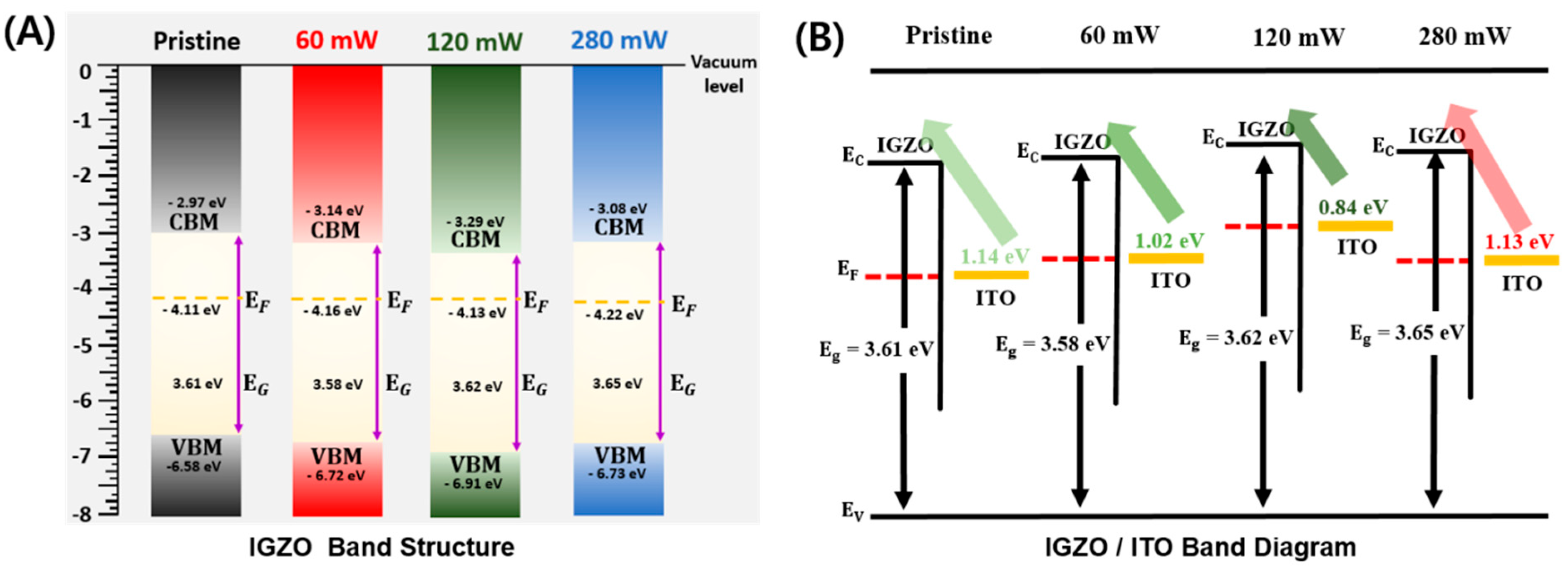
| Reference | Oxide Composition /Deposition Process | Source-Drain Deposition/Channel Length | Laser Specification | Laser Annealing Conditions |
|---|---|---|---|---|
| This study | a-IGZO/RF sputtering | ITO sputtering/2~6 μm | 355 nm (Nd:YVO4), nanosecond (35 ns) | Scanning at 100 mm/s, 55~280 mW @ 20 μm beam size, 100 kHz |
| [25] | In2O3/solution process | Al evaporation/200 μm | 700 nm (Ti:sapphire), femtosecond (pulse width not reported) | No scan, 30, 60, 90 s at 97 W/cm2, repetition rate not reported |
| [26] | a-IGZO/RF sputtering | MoW sputtering/200 μm | 800 nm (Ti:sapphire), femtosecond (140 fs) | No scan, 3 W, 80 MHz |
| [27] | Stacked IZO/solution process | Sputtering/200 μm | 700 nm (Ti:sapphire), femtosecond (pulse width not reported) | No scan, 50, 100, 200 s at 3 W2 |
| [28] | a-IGZO/RF sputtering | ITO sputtering/80 μm | 308 nm (XeCl), nanosecond (25 ns) | Scanning mode (scan speed not reported), fluence: up to 500 mJ/cm2 |
| [29] | a-IGZO/RF sputtering | Mo/Pt sputtering/10 μm | 308 nm (XeCl), nanosecond (25 ns)/248 nm (KrF), pulse width not reported | Single shot, fluence: 80~110 mJ/cm2 |
| [30] | a-IGZO/RF sputtering | Ti/Au evaporation/50 μm | 10.6 μm CO2, continuous wave | Scanning at 100 mm/s, up to 400 W/cm2 |
| Laser Power | VTH [V] | S.S. [V/dec] | μn [cm2/V·s] | Ion/Ioff |
|---|---|---|---|---|
| Pristine | 2.48 | 2.00 | 0.84 | 4.06 × 107 |
| 54 mW | 2.76 | 1.77 | 1.20 | 6.79 × 107 |
| 60 mW | 1.19 | 1.81 | 0.77 | 1.88 × 107 |
| 77 mW | −0.77 | 1.81 | 0.35 | 2.41 × 108 |
| 90 mW | −1.10 | 1.61 | 0.30 | 4.84 × 108 |
| 119 mW | −1.39 | 1.86 | 1.13 | 2.91 × 107 |
| 155 mW | −1.88 | 2.28 | 0.32 | 5.42 × 107 |
| 202 mW | −4.47 | 2.64 | 0.03 | 4.62 × 107 |
| 227 mW | - | - | - | 3.45 × 100 |
| 253 mW | - | - | - | 4.27 × 100 |
| 280 mW | - | - | - | 1.36 × 101 |
Disclaimer/Publisher’s Note: The statements, opinions and data contained in all publications are solely those of the individual author(s) and contributor(s) and not of MDPI and/or the editor(s). MDPI and/or the editor(s) disclaim responsibility for any injury to people or property resulting from any ideas, methods, instructions or products referred to in the content. |
© 2024 by the authors. Licensee MDPI, Basel, Switzerland. This article is an open access article distributed under the terms and conditions of the Creative Commons Attribution (CC BY) license (https://creativecommons.org/licenses/by/4.0/).
Share and Cite
Park, S.Y.; Choi, Y.; Seo, Y.H.; Kim, H.; Lee, D.H.; Truong, P.L.; Jeon, Y.; Yoo, H.; Kwon, S.J.; Lee, D.; et al. 355 nm Nanosecond Ultraviolet Pulsed Laser Annealing Effects on Amorphous In-Ga-ZnO Thin Film Transistors. Micromachines 2024, 15, 103. https://doi.org/10.3390/mi15010103
Park SY, Choi Y, Seo YH, Kim H, Lee DH, Truong PL, Jeon Y, Yoo H, Kwon SJ, Lee D, et al. 355 nm Nanosecond Ultraviolet Pulsed Laser Annealing Effects on Amorphous In-Ga-ZnO Thin Film Transistors. Micromachines. 2024; 15(1):103. https://doi.org/10.3390/mi15010103
Chicago/Turabian StylePark, Sang Yeon, Younggon Choi, Yong Hyeok Seo, Hojun Kim, Dong Hyun Lee, Phuoc Loc Truong, Yongmin Jeon, Hocheon Yoo, Sang Jik Kwon, Daeho Lee, and et al. 2024. "355 nm Nanosecond Ultraviolet Pulsed Laser Annealing Effects on Amorphous In-Ga-ZnO Thin Film Transistors" Micromachines 15, no. 1: 103. https://doi.org/10.3390/mi15010103
APA StylePark, S. Y., Choi, Y., Seo, Y. H., Kim, H., Lee, D. H., Truong, P. L., Jeon, Y., Yoo, H., Kwon, S. J., Lee, D., & Cho, E.-S. (2024). 355 nm Nanosecond Ultraviolet Pulsed Laser Annealing Effects on Amorphous In-Ga-ZnO Thin Film Transistors. Micromachines, 15(1), 103. https://doi.org/10.3390/mi15010103









